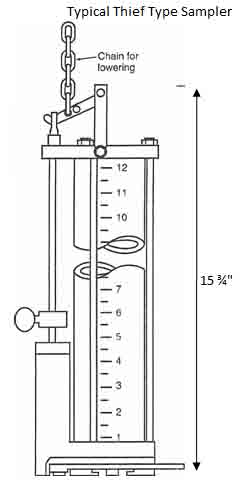|
Additional
consideration should be given as to how the sample will be used. Each
device should be used in the manner prescribed by its
manufacturer.
Additional
technical data on open manual sampling equipment, is available in API
MPMS Chapter 8.1.
 Liquid
Petroleum-Open Sampling Equipment Liquid
Petroleum-Open Sampling Equipment
There
are several containers (receivers) which are used to sample cargo. The
most common types currently in use are the weighted glass bottle,
beaker thief, and zone sampler. When the weighted glass
bottle method is used, each sample can be stored in the bottle it was
taken in. This minimizes the risk of loss of light ends and
accidental introduction of water.
The
use of a beaker or thief to obtain a tank sample may run the risk of
loss of quality of the sample through contamination, loss of light
ends, introduction of water, etc. This potential risk results
from the need to transfer the sample from the beaker to another
container for transportation to the laboratory. During the
transfer from the beaker, light ends will be lost and outside moisture
may be introduced. In addition, the use of the same beaker to sample
more than one tank may cause a contaminant to be introduced to an
otherwise uncontaminated
sample.
Free Water-Open Sampling Equipment
As
with cargo sampling, there are several containers that can be used to
sample free water at the bottom of vessel tanks with the most common
being a bottom sampler (tube container), glass bottle, or thief.
If
the free water level is higher than 1 foot, a weighted bottle can be
used. Otherwise, a bottom sampler or thief must be
used. Bottom or thief samplers are usually used to sample
free water under a cargo. A typical bottom sampler has a
projecting stem on a valve rod that opens two valves automatically as
the stem strikes the bottom of the tank. The sample enters
the container through the bottom valve, and air is simultaneously
released through the top valve. The valves snap shut when the
sampler is lifted
Sediment-Open Sampling Equipment
A scoop sampler is used to sample sediment on the bottom of vessel
tanks that is not covered by a liquid
Sample Containers
Containers
used for samples taken from vessel tanks are usually clear or brown
glass bottles, plastic bottles, or metal cans. The only cans
that may be used are those with seams soldered on the can's exterior
surface with a flux of rosin cleaned in a suitable solvent.
If
the cargo sample is sensitive to light, brown bottles should be
used. To minimize the loss of light ends, appropriate
high-quality, clean, cork or glass stoppers, bungs, or screw caps
should be used to seal sample container. Rubber stoppers
should never be used.
It
may be noted that the manufacturer should be consulted if there is any
question about the acceptability of the construction or type of
material of a container or cap.
Inspection of Sampling Equipment
Before
use, all sampling equipment (including containers and cords or chains)
shall be inspected to ensure that they are clean, dry, and free from
all substances that might contaminate the sample. The use of
dirty sample cords or tapes should be avoided because of the
possibility of a sample being contaminated. In addition,
certain cargoes may require special precautions to be taken when
preparing sampling equipment (i.e., nitrogen purging of sample
containers to assure dryness). The principals involved should
be consulted if there are any questions as any special requirements
necessary.
Sections of text taken from API - MPMS Chapter 17 Marine Measurement
|